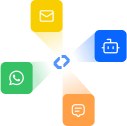In today’s connected world, businesses have more ways than ever to reach their customers, but not all channels are created equal. Among the most powerful are SMS, Email, and WhatsApp — three pillars of modern customer communication.
Each serves a different purpose, offers unique advantages, and fits specific customer behaviors.This guide compares them across key dimensions — reach, engagement, cost, and compliance — so you can choose the right mix for your strategy.
Why Compare These Channels?
The marketing technology landscape is crowded, yet these three channels consistently deliver results because they are:
| Attribute | Why It Matters | |
|---|---|---|
| Direct-to-Consumer | Messages go straight to the user’s phone or inbox — no algorithm or platform gatekeeping. | |
| Consent-Based | Audiences usually opt in, so engagement rates are high and spam risk is low. | |
| Automatable | Campaigns and triggers (e.g., cart recovery, reminders) can run 24/7 without manual intervention. |
Still, most businesses face a key question:
Should we double down on SMS, stay with Email, or expand into WhatsApp for conversational engagement?
SMS Marketing
SMS may be one of the oldest digital channels, but it remains one of the most effective and fastest ways to get customer attention.
Messages arrive instantly on virtually every phone — no apps, no internet required.
Strengths
- Unmatched Open Rates: Over 90% of messages are read within minutes.
- Speed: Ideal for urgent reminders, flash sales, OTPs, and time-sensitive updates.
- Simplicity: Works on any device and doesn’t depend on app installs or data connections.
Limitations
- Character Limit: Restricted to short, concise messaging (typically 160 characters).
- Cost: Per-message charges can add up for large-scale campaigns.
- Design Constraints: No visuals or media — plain text only, unlike email or WhatsApp.
Best Use Cases
| Scenario | Why SMS Wins | |
|---|---|---|
| One-time passwords (OTPs) | Universal delivery, instant reach. | |
| Appointment reminders | High visibility and quick response. | |
| Flash or limited-time offers | Immediate attention and action. | |
| Delivery updates | Simple, fast notifications. |
When to Use SMS, Email, and WhatsApp for Marketing
Each channel shines in different scenarios. The key is to match the message to the moment — urgency, content depth, and interaction level determine the right tool.
SMS Marketing
When to Use SMS
Use SMS for time-sensitive alerts and instant calls-to-action, such as:
- Appointment confirmations or reminders.
- Delivery notifications and status updates.
- Password resets or OTP verification.
- Flash sales and short promotional nudges.
SMS excels when speed and visibility are critical.
Email Marketing
Email remains the backbone of digital communication for long-form, detailed, or visually rich content.
Strengths
- Rich Formatting: Embed images, buttons, CTAs, and templates for a polished look.
- Low Cost: Highly scalable — ideal for large audiences.
- Perfect for Nurturing: Enables drip campaigns, newsletters, and content-driven engagement.
Limitations
- Lower Open Rates: Many emails go unread or end up in spam folders.
- Delayed Response: Recipients may check inboxes hours later.
- Inbox Clutter: Competes with dozens of other brand messages daily.
When to Use Email
Opt for email when you need to share detailed, long-form, or visually rich content, such as:
- Product catalogs or promotional brochures.
- Onboarding guides and tutorials.
- Educational series or newsletters.
- Personalized nurture journeys over time.
Email is best for storytelling and sustained engagement, not urgent alerts.
WhatsApp Marketing
WhatsApp — and similar OTT (Over-The-Top) messaging apps — are now essential business communication platforms, especially in high-adoption markets like India, Brazil, and parts of Europe.
Strengths
- Massive Global Reach: In some regions, WhatsApp has more active users than email.
- Rich, Interactive Messaging: Supports images, videos, PDFs, buttons, and product catalogs.
- Two-Way Communication: Enables real-time Q&A, orders, or support directly in chat.
- Personal Touch: Messages feel conversational, not corporate — increasing trust and engagement.
Limitations
- Template and Compliance Requirements: Proactive business messages often need pre-approved templates.
- Strict Consent Rules: You must obtain explicit opt-in before messaging users.
- Variable Costs: Pricing depends on conversation type (marketing, utility, authentication) and region.
When to Use WhatsApp
Choose WhatsApp when you need interactive, two-way communication and want to make messaging feel personal and instant:
- Product inquiries or guided purchases.
- Appointment confirmations or service updates.
- Conversational promotions and loyalty programs.
- Customer support and feedback collection.
WhatsApp bridges the gap between SMS urgency and email depth — ideal for conversational engagement.
Use WhatsApp for customer support, conversational marketing, and personalized updates that require interaction or confirmation.
Ideal use cases include:
- Customer support chats — fast answers and human handoff.
- Conversational campaigns — product discovery, feedback, loyalty reminders.
- Personalized updates — order confirmations, delivery tracking, appointment changes.
- Interactive promotions — clickable buttons, quick replies, and catalogs.
Think of WhatsApp as your “always-on” customer desk — human warmth with automation spee
Comparing SMS, Email, and WhatsApp
Here’s how the three channels compare across key marketing and operational factors:
| Factor | SMS | ||
|---|---|---|---|
| Reach & Accessibility | Works on all phones; no internet required. | Needs internet and active inbox access. | Requires app install; globally adopted. |
| Engagement | Highest open/read rates; responses within minutes. | Lower opens, but great for detailed content and nurturing. | Very high engagement due to conversational flow. |
| Content Flexibility | Text-only, 160-character limit. | Fully customizable — supports long copy, design, images, and CTAs. | Combines text, images, buttons, quick replies, and catalogs. |
| Cost | Cost per message can rise quickly at scale. | Lowest cost per contact, ideal for large audiences. | Variable — depends on message type and region; usually between SMS and email. |
| Compliance & Consent | Strict opt-in and DLT/telecom rules in many markets. | Established consent norms (double opt-in advised). | Requires explicit opt-in and template approval for outbound messages. |
| Best Suited For | Urgent alerts, OTPs, short promos. | Long-form content, newsletters, onboarding. | Customer support, interactive campaigns, personalized engagement. |
Summary Insight
Each channel excels in its own niche:
- SMS → Urgent, universal, and high-impact for quick actions.
- Email → Rich, detailed, and scalable for storytelling and nurture flows.
- WhatsApp → Conversational, interactive, and perfect for building lasting customer relationships.
Smart teams don’t choose one — they combine all three strategically.
Which Works Best?
There’s no single winner — only the right channel for the right goal.Each shines in specific moments of the customer journey.
| Your Goal | Best Channel | Why It Works |
|---|---|---|
| Speed & Urgency | SMS | Delivers instantly; perfect for OTPs, reminders, and flash sales. |
| Depth & Storytelling | Ideal for detailed content, nurturing sequences, and brand storytelling. | |
| Interactive Engagement | Enables two-way communication, support, and personalized updates. |
The Smart Strategy: Use All Three Together
The most effective approach isn’t choosing one — it’s orchestrating all three to complement each other:
- Use SMS → for instant attention and time-sensitive alerts.
- Use Email → for rich storytelling, onboarding, and long-form content.
- Use WhatsApp → for interactive conversations, customer care, and real-time updates.
When combined, they create a connected customer experience that feels effortless and personal.
Final Word
The future of communication isn’t SMS vs Email vs WhatsApp — it’s SMS + Email + WhatsApp.Each channel plays a distinct role in a seamless journey.
Example Flow:
A customer signs up → gets a confirmation via SMS → receives onboarding content by Email → and later chats with Support on WhatsApp.
Together, these touchpoints build a journey that is: Immediate (via SMS), Informative (via Email), Conversational (via WhatsApp)
In short: Don’t compete with your channels — coordinate them. That’s how modern businesses turn communication into connection.



